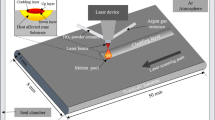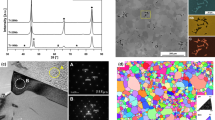Abstract
Active brazing is a commonly used method for joining ceramic materials. In the present study, the wetting behavior of four Ti-rich ternary Ni–Ti–Zr alloys was investigated through sessile drop experiments on alumina disks of 96 and 99.9 % purity. The microstructure at the metal/alumina interface was analyzed using scanning electron microscopy and energy-dispersive X-ray spectroscopy. Three of the analyzed alloys exhibited reactive wetting with final contact angles between 40° and 70°. The reaction phases at the metal/alumina interface had a thickness of about 1 µm and were of a similar composition for all alloys. Dilatometer measurements showed thermal expansion coefficients between 13.2 and 15.8 × 10−6 °C−1. The lowest wetting angle of 40° was achieved with the alloy 61Ti–20Zr–19Ni at temperatures above 980 °C.





Similar content being viewed by others
References
Nicholas MG (ed) (1990) Joining of ceramics. Chapman and Hall, London
Eustathopoulos N (2005) Progress in understanding and modeling reactive wetting of metals on ceramics. Curr Opin Solid State Mater Sci 9(4–5):152–160
Eustathopoulos N (1998) Dynamics of wetting in reactive metal ceramic systems. Acta Mater 46(7):2319–2327
Saiz E, Tomsia AP (2005) Kinetics of high-temperature spreading. Curr Opin Solid State Mater Sci 9(4–5):167–173
Saiz E, Cannon RM, Tomsia AP (2000) Reactive spreading: adsorption, ridging and compound formation. Acta Mater 48(18–19):4449–4462
Gomez-Garcia D, Gutierrez-Mora F, Gallardo-Lopez A, Dominguez-Rodriguez A (2007) A general law for liquid metal-onto-ceramic wetting: an electrostatic approach. J Eur Ceram Soc 27(11):3307–3310
Akselsen OM (1992) Advances in brazing of ceramics. J Mater Sci 27(8):1989–2000. doi:10.1007/BF01117909
Kumar G, Prabhu KN (2007) Review of non-reactive and reactive wetting of liquids on surfaces. Adv Colloid Interface Sci 133(2):61–89
Schwartz Mel M (1990) Ceramic joining. ASM International, London
Naidich YV, Zhuravlev VS, Gab II, Kostyuk BD, Krasovskyy VP, Adamovskyy AA, Taranets NY (2008) Liquid metal wettability and advanced ceramic brazing. J Eur Ceram Soc 28(4):717–728
Gupta KP (1999) The Ni–Ti–Zr system (nickel–titanium–zirconium). J Ph Equilib 20(4):441–448
Martienssen W, Warlimont H (2005) Springer handbook of condensed matter and materials data. Springer, Berlin
Meier A, Chidambaram PR, Edwards GR (1995) Generation of isothermal spreading data for liquid reactive metals on ceramic substrates: the copper–titanium/alumina system. J Mater Sci 30:3791–3798. doi:10.1007/BF01153936
Davis JP, Majzoub EN, Simmons JM, Kelton KF (2000) Ternary phase diagram studies in Ti–Zr–Ni alloys. Mat Sci Eng A 294:104–107
Wu M, Cao CZ, Rafi ud din, He XB, XH Qu (2013) Brazing diamond/Cu composite to alumina using reactive Ag–Cu–Ti alloy. Trans Nonferr Met Soc China 23(6):1701–1708
Voytovych R, Robaut F, Eustathopoulos N (2006) The relation between wetting and interfacial chemistry in the CuAgTi/alumina system. Acta Mater 54(8):2205–2214
Hosking FM et al (2000) Microstructural and mechanical characterization of actively brazed alumina tensile specimens. Weld J Res Suppl 79(8):222–230
Lin C, Chen R, Shiue R (2001) A wettability study of Cu/Sn/Ti active braze alloys on alumina. J Mater Sci 36(9):2145–2150. doi:10.1023/A:1017531730604
Jasim KM et al (2010) Actively brazed alumina to alumina joints using CuTi, CuZr and eutectic AgCuTi filler alloys. Ceram Int 36(8):2287–2295
Shiue RK, Wu SK, O JM, Wang JY (2000) Microstructural evolution at the bonding interface during the early-stage infrared active brazing of alumina. Metall Mater Trans A 31(10):2527–2536
Halbig MC, Coddington BP, Asthana R, Singh M (2013) Characterization of silicon carbide joints fabricated using SiC particulate-reinforced Ag–Cu–Ti alloys. Ceram Int 39(4):4151–4162
Author information
Authors and Affiliations
Corresponding author
Rights and permissions
About this article
Cite this article
Siegmund, P., Guhl, C., Schmidt, E. et al. Reactive wetting of alumina by Ti-rich Ni–Ti–Zr alloys. J Mater Sci 51, 3693–3700 (2016). https://doi.org/10.1007/s10853-015-9684-7
Received:
Accepted:
Published:
Issue Date:
DOI: https://doi.org/10.1007/s10853-015-9684-7




